
The loa are the spirits of Haitian Vodou and Louisiana Voodoo. They are intermediaries between Bondye – the Supreme Creator, who is distant from the world – and humanity. Unlike saints or angels, however, they are not simply prayed to, they are served. They are each distinct beings with their own personal likes and dislikes, distinct sacred rhythms, songs, dances, ritual symbols, and special modes of service. Contrary to popular belief, the loa are not deities in and of themselves; they are intermediaries for, and dependent on, a distant Bondye or god.

Vodun is practiced by the Aja, Ewe, and Fon peoples of Benin, Togo, Ghana, and Nigeria.
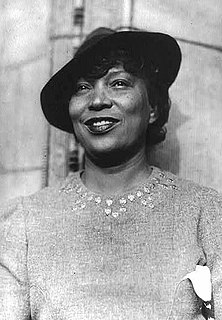
Zora Neale Hurston was an American author, anthropologist, and filmmaker. She portrayed racial struggles in the early-1900s American South and published research on hoodoo. The most popular of her four novels is Their Eyes Were Watching God, published in 1937. She also wrote more than 50 short stories, plays, and essays.

Damballa, also spelled Damballah, Dambala, Dambalah, among other variations, is one of the most important of all loa, spirits in Haitian Vodou and Louisiana Voodoo traditions. He is portrayed as a great white serpent, originating in the city of Wedo in modern-day Benin. Damballa is said to be the Sky Father and the primordial creator of all life, or the first thing created by Gran Met. In those Vodou societies that view Damballa as the primordial creator, he created the cosmos by using his 7,000 coils to form the stars and the planets in the heavens and to shape the hills and valleys on earth. In others, being the first thing created by God, creation was undertaken through him. By shedding the serpent skin, Damballa created all the waters on the earth. As a serpent, he moves between land and water, generating life, and through the earth, uniting the land with the waters below. Damballa is usually syncretized with either Saint Patrick or Moses. He is counted among the Rada loa.

Erzulie is a family of loa, or spirits, in Vodou.
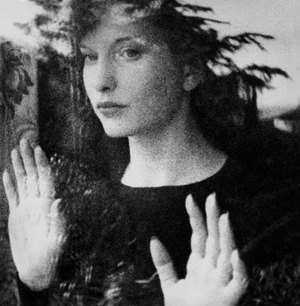
Maya Deren was a Ukrainian-born American experimental filmmaker and important promoter of the avant-garde in the 1940s and 1950s. Deren was also a choreographer, dancer, film theorist, poet, lecturer, writer, and photographer.

Houngan or oungan is the term for a male priest in Haitian Vodou. The term is derived from the Fon word hounnongan. Houngans are also known as makandals.
Bois Caïman was the site of the first major meeting of enslaved Blacks during which the first major slave insurrection of the Haitian Revolution was planned.

The PJs is an American adult animated stop-motion black sitcom, created by Eddie Murphy, Larry Wilmore, and Steve Tompkins. It portrayed life in an urban public housing project, modeled after the Cabrini–Green housing projects in Chicago. The series starred Eddie Murphy, and was produced by Imagine Entertainment by Ron Howard and Brian Grazer, The Murphy Company and Will Vinton Studios in association with Touchstone Television, marking the show as Disney's first adult animated series. The original run of the series debuted on Fox on Sunday, January 10, 1999, following the network's coverage of the NFC Divisional Playoffs. Two days later, the second episode aired in its regular Tuesday night time slot, following King of the Hill. The title is an abbreviation for "the projects", referring to the show's public housing highrise.
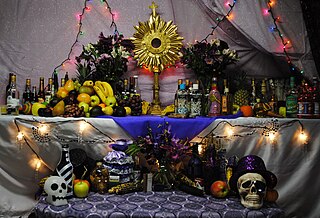
Homosexuality in Haitian Vodou is religiously acceptable and homosexuals are allowed to participate in all religious activities. However, in countries with large Vodou populations, some Christian influence may have given homosexuality a social stigma, at least on some levels of society.
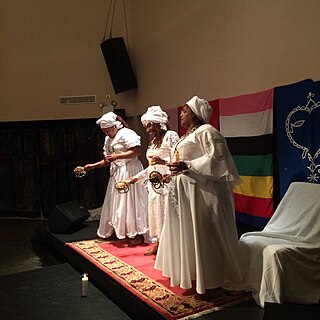
A mambo is a priestess in the Haitian Vodou religion. Haitian Vodou's conceptions of priesthood stem from the religious traditions of enslaved people from Dahomey, in what is today Benin. For instance, the term mambo derives from the Fon word nanbo. Like their West African counterparts, Haitian mambos are female leaders in Vodou temples who perform healing work and guide others during complex rituals. This form of female leadership is prevalent in urban centers such as Port-au-Prince. Typically, there is no hierarchy among mambos and houngans. These priestesses and priests serve as the heads of autonomous religious groups and exert their authority over the devotees or spiritual servants in their hounfo (temples). Mambos and houngans are called into power via spirit possession or the revelations in a dream. They become qualified after completing several initiation rituals and technical training exercises where they learn the Vodou spirits by their names, attributes, and symbols. The first step in initiation is lave tèt, which is aimed at the spirits housed in an individual's head. The second step is known as kouche, which is when the initiate enters a period of seclusion. Typically, the final step is the possession of the ason, which enables the mambos or houngan to begin their work. One of the main goals of Vodou initiation ceremonies is to strengthen the mambo's konesans (knowledge), which determines priestly power.
Divine Horsemen: The Living Gods of Haiti (1954) is a black-and-white documentary film of approximately 52 minutes. It is about dance and possession in Haitian vodou that was shot by experimental filmmaker Maya Deren between 1947 and 1954.

Haitian Vodou is an African diasporic religion that gradually developed in Haiti between the 16th and 19th centuries. It arose through a process of syncretism between the traditional religions of West Africa and the Roman Catholic form of Christianity. Adherents are known as Vodouists or "servants of the spirits". There is no central authority in control of Vodou, which is organised through autonomous groups.

The Kingdom of This World is a novel by Cuban author Alejo Carpentier, published in 1949 in his native Spanish and first translated into English in 1957. A work of historical fiction, it tells the story of Haiti before, during, and after the Haitian Revolution led by Toussaint Louverture, as seen by its central character, Ti Noel, who serves as the novel's connecting thread. Carpentier's work has been influenced by his multi-cultural experience and his passion for the arts, as well as by authors such as Miguel de Cervantes. The novel stems from the author's desire to retrace the roots and history of the New World, and is embedded with what Carpentier calls "lo real maravilloso" or "the marvelous real"—a concept he introduced to the world of literature.
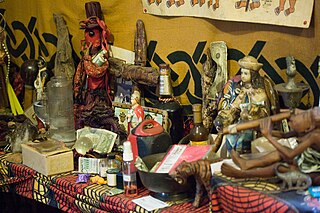
Louisiana Voodoo, also known as New Orleans Voodoo, is a set of spiritual beliefs and practices developed from the traditions of the African diaspora in Louisiana. It is sometimes referred to as Mississippi Valley Voodoo when referring to its historic popularity and development in the greater Mississippi Valley. It is a cultural form of the Afro-American religions developed by the West and Central African populations of the U.S. state of Louisiana. Voodoo is one of many incarnations of African-based spiritual folkways, rooted in West African Dahomeyan Vodun.
Vodou drumming and associated ceremonies are folk ritual faith system of henotheistic religion of Haitian Vodou originated and inextricable part of Haitian culture.

Killjoy 2: Deliverance from Evil is a 2002 American slasher film and sequel to Full Moon's hit horror movie, Killjoy.

Faustin Edmond Wirkus was an American Marine stationed in Haiti during the United States occupation of Haiti (1915-1934). He was reputedly crowned Faustin II, King of La Gonâve, a Haitian island west of Hispaniola, by Queen Ti Memenne of La Gonâve on 18 July 1926, and co-ruled until he was transferred by the United States Marine Corps to the United States mainland in 1929.
Marie Kingué was a famous midwife, kaperlata medicine woman and voodoo priestess active in Saint Domingue.

Queen Ti Memenne of La Gonâve was the tribal ruler of La Gonâve, a Haitian island located west of Hispaniola in the Gulf of Gonâve. While her reign was not officially recognized by the republican government of Haiti during American occupation, she maintained political, economic, spiritual, and social leadership of the island. Arrested by the Garde d'Haiti for being a practitioner of Vodou, she was shown compassion by Faustin E. Wirkus, an American military officer who assisted in her release. She later proclaimed Wirkus to be the reincarnation of former Haitian Emperor Faustin Soulouque and crowned him as a co-ruler over La Gonâve.
















